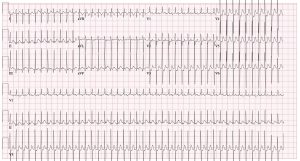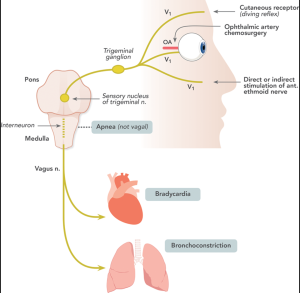
A 3 week old male, born NSVD 40w6d, presents to the ED with 2 days of feeding intolerance. Initial vitals show a heart rate of 260, bp 83/51, RR 40, sat 100% RA, temp 37C. You quickly get an EKG pictured below that shows a regular, narrow complex tachycardia consistent with SVT. What is your next move?
In a stable patient with SVT, consider eliciting the diving reflex.
What is the diving reflex?
It’s a cardiovascular reflex first noticed in oceanic mammals, specifically seals, that frequently undergo deep dives to cooler depths. The purpose of the reflex is two fold: 1) to increase the efficiency of oxygen consumption by decreasing the heart rate 2) to redirect blood flow through peripheral vasoconstriction.
How does it work in humans?
The reflex is mediated by trigeminal nerve temperature receptors in the face. Once stimulated, nerve fibers carry a signal to the trigeminal nerve sensory nucleus in the pons. The trigeminal nerve sensory nucleus then activates the vagus nerve in the medulla leading to increased vagal tone on the heart with and slowing of AV nodal conduction.
How do you elicit the reflex?
Unfortunately there isn’t a standardized way to perform this procedure and limited quality data exists. The article below suggests the water be at least 10C for maximum effect and for at least 40seconds. Practically speaking, take a bag of crushed ice, gently apply the bag across the nasal bridge, forehead without occluding the nostrils or mouth, and apply gentle pressure for 40 seconds. A few studies cited by this review article from the 80s-90s suggest high rates of spontaneous conversion amongst the pediatric population.
TLDR: If taking care of a pediatric patient with SVT, chill them out with some ice for 40seconds.
Source:
Smith G et. al. Use of the human dive reflex for the management of supraventricular tachycardia: a review of the literature. Emerg Med J. 2012 Aug;29(8):611-6


